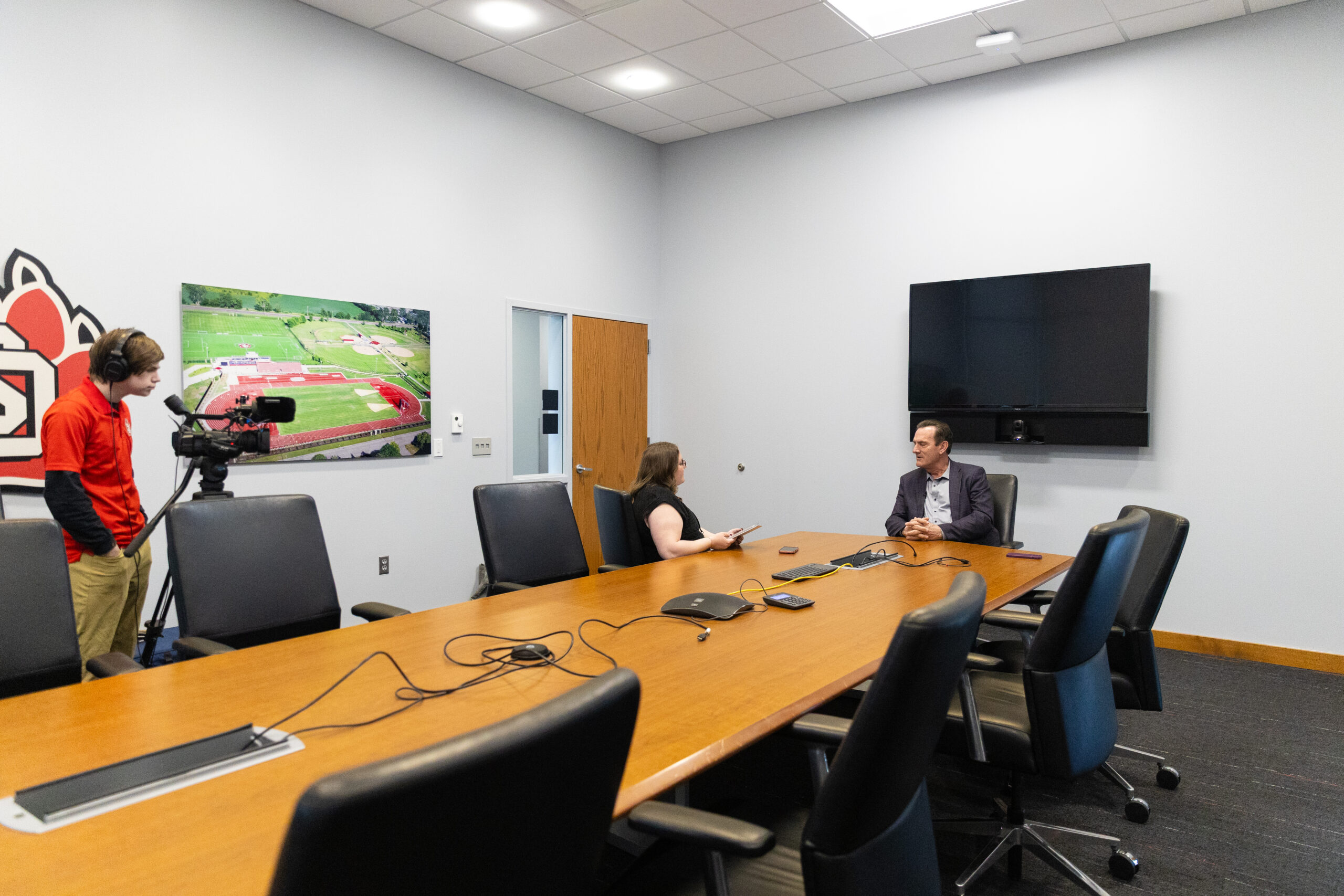
South Dakota Governor Larry Rhoden Q&A
On Thursday, April 10, South Dakota Governor Larry Rhoden visited various businesses within the Vermillion community, as well as attended the University of South Dakota’s campus as a part of his Open for Opportunity Tour. While in Vermillion the governor took the time to walk through Manitou Equipment, Masaba Inc and the Human Services Center to gain insight into the operations of industries within the state. Rhoden also sat down with The Volante and Coyote News to discuss South Dakota economics, recent legislation, as well as policies that may affect students alongside the broader community.
Q: How does The Open for Opportunity Tour align with your long-term goals for South Dakota’s economic development?
A: [Rhoden] “Well, I, you know, I think that’s the foundation for development. We’ve been doing very well. Our economy is strong. It has been, you know, we were open for business during COVID and, you know, I think we are the freest in the nation and our economy has benefited from that. And so when I took the reins, not only are we open for business, we’re open for opportunity. That’s the foundation of our Open for Opportunity Tour. Obviously, and as we’ve gone around the state and visited more businesses, our conversation with business owners, farmers, ranchers and citizens across the board in South Dakota, has been extremely encouraging. The information we glean from them about what their impediments are toward furthering opportunity. Even today, in the tours that we had, to hear what their challenges are and what we’ve done right as a state. And then so, you know, that’s a foundation for me and my administration moving forward, to see what we can do as a state to get out of the way of business people, number one and allow them to flourish more than anything else. Right now we have an opportunity with the Trump administration and the steps he’s taken to strengthen our economy and secure our future, I think, go hand in glove, because South Dakota, more than any other state, has positioned themselves to survive the short term pain that some of the you know, the cuts in federal spending are going to bring, we’re in better shape than any state because, you know, after COVID, when there were all the COVID dollars flowing back to the States more so than any other state in the nation. We turned down a lot of those federal dollars. We’re the only state in the nation that, when they offered extended unemployment benefits, South Dakota said, ‘thanks, but no thanks’. Our people want to go to work and they did, and now we have a thriving economy. Lowest unemployment in the nation by far, set a new record for the lowest unemployment. We’ve won the Governor’s Cup two years running, which means we’re the best state in the nation as far as per capita economic development projects. So we have a lot of things to be excited about in South Dakota and so I’m going to spend my time as governor trying to expand on that. Freedom is prevalent in South Dakota and freedom will be my calling card for as long as I’m Governor.”
Q: How does the tour support the unique needs of university towns such as vermillion, yet more specifically what strategies are you implementing in support of local businesses across the state as a part of this initiative?
A: “You know, what we just talked about is a big part of that and we’ve toured, I think there’s only two universities we haven’t been on campus so far. Just had a meeting with President Gestring and met with a group of students and they shared with us what their perspectives were and where they’re at and so through those conversations, we find areas that we can look into to maybe help enhance their ability to be in the right place or in the right job in South Dakota, that is the job of their dreams. We can do things in the governor’s office to help facilitate. I’ve been calling it a clearing house, or, you know, just the ability to coordinate with and between business owners, like we met earlier today and get them coordinated with the universities to put students in the right place and provide them opportunities through, apprenticeships or whatever to get them to a job of their dreams.”
Q: How do the recent property tax relief measures reflect your commitment to easing financial burdens for South Dakota residents? Are there any measures being considered to directly assist college students who are facing rising living costs?
A: “Well, on the property tax side, that has been an issue in the years since COVID. We’ve had and seen in certain areas of the state, distinct problems in owner occupied taxes on your home. And during the session, I brought forward a Senate Bill, 216 which was designed to, you know, put a 3% cap on the increase in owner occupied homes, so it was a five year cap to stop the bleeding or stop those dramatic increases. I said at the time that we needed more, that was a starting point. We needed more dramatic tax cuts. In the last week of session, we came up with an idea I didn’t want to try as It hadn’t been vetted. I didn’t think it was a good process to try and figure that out in the last week of session. So on veto day, I announced to the legislature a proposal to create a tax relief for property owner’s, property owner’s occupied homes, which consisted of a local option, half percent sales tax. Other words, the counties could adopt this half cent sales tax, and the proceeds on that would be used to pay down the property taxes for owner occupied. In most cases, we settle at a half percent, because in most cases, in the counties that were most impacted by the rising costs, that would be enough to completely erase their county taxes on owner occupied. And we introduced it in a way that if there were more proceeds than just what it took to erase the property tax on owner occupied, the rest of it would be used on the other class of property, to supplant some of those dollars. And it really represents a tax cut for South Dakotans, because a lot of the areas where they would probably adopt this half cent sales tax have a great deal of tourism dollars coming in the form of sales tax, so we’re actually shifting some of the tax burden onto people from out of state that are doing their shopping here.”
Q: Your support for concealed carry on college campuses has sparked significant debate state-wide. How would you address the concerns of college students, faculty, as well as community members regarding campus safety with the implementation of concealed weapons?
A: “Well, you know, that’s been an ongoing debate for years. There were bills 15 years ago when I was in the legislature about guns on campus and someone got pretty close to the finish line and there was always this ongoing fear about what that would bring forward, much like the fear that they had about implementing constitutional carry statewide. We did that six years ago. In fact, it was the first bill under the Noem-Roden administration that Kristi Noem signed into law. And I talked about the other day, there were a lot of people that were fretful about that for a lot of years, yet that was done six years ago and none of those fears have come to fruition. So sometimes I think we’re overly reluctant to trust the people and restore rights. You know, I think the Second Amendment is pretty clear in its language and so we shouldn’t take any kinds of restrictions on our constitutional rights lightly. And if we can restore them, which we did in constitutional carry, we should do that. I think the guns on campus, in addition to where it was, you know, when we debated it years ago in the legislature, now, they had even more safeguards in place. I think it’s significant that in order to carry on campus, you have to have an enhanced concealed carry permit. I went through the course to get that, and it’s pretty extensive and so now we have students who are adults, the same age as other kids that are carrying guns in foreign countries defending our nation, I don’t think it’s unreasonable that they should have the same rights as anyone else that’s an adult in South Dakota.”
Q: What steps has your administration taken and or are planning to take to ensure clear guidelines and training for those participating in concealed carry on campuses such as USD?
A: “I think that’s pretty easy. You know, I don’t know what, I haven’t read the bill as far as the regulations and the stipulations for reporting, but I’m sure the regents can, you know, they’ll have the ability to know who’s carrying on the campus. So I don’t know enough about the details to comment as far as how that will be managed.”
Q: What are some of your key priorities for strengthening South Dakota’s economy while maintaining its appeal as a business-friendly state?
A: “Well, I think again, we’ve talked about the steps that we’ve taken through this Open for Opportunities Program, and I think that it’s not as complicated as people think, you know, we’ve got the opportunity now, you know. And this kind of ties to a broader discussion about our national economy and what President Trump has started as far as DOGE, Department of Government Efficiencies, people have asked me, why don’t we have a State DOGE? And my response is, well, we really do, and we really have. The federal program has presented an opportunity for us as a state, because a number of our state agencies have the bulk of their budget come from federal dollars, and I’ve met with all our Cabinet Secretaries and given them instructions to be combing through their regulations that were dictated from the federal level and those that are antiquated or nonsensical or overburdensome or unnecessary. This is an opportunity for us to glean those and send them, or kick them up to the federal level, where they’re diligently looking for that kind of cannon fodder, if you will. And it gives the states the opportunity to make their government more efficient at the same time lessening regulations on businesses and opening the door, presenting more opportunity for businesses to expand or to move here. It’s been extremely encouraging, talking especially to business owners even today that moved here from other states because of our business friendly environment and then the excitement and the enthusiasm that they exude in being here and it’s just like they found their home and we need to spread that message and we need to protect that kind of mode of operation that we continue to be lead the nation, as far as you know, opening arms to businesses.”
Q: How do you see the recent 2.9% tuition increase impacting South Dakota’s students, and what measures are you considering to ensure higher education remains accessible within the state?
A: “Yeah? Well, we had a tough, much tougher budget this year, but I think we were on a two or three year tuition freeze prior to that and so I don’t think it was, you know, certainly wasn’t unreasonable, the small percentage that increased this year. Obviously we’ll take it one year at a time, as we see what our economy has done next year? We expected this at some point. We had several years where the economy was just growing leaps and bounds with COVID, dollars coming into our state because of the way we had managed, gotten through that in a much better condition than other states. We had a huge amount of one time dollars floating around that we used to build our infrastructure and pay down debt and made wise decisions on the use of that money, but now we’re getting back to a more normal economy and so I think we’re kind of in transition and getting back to a place where we’re not setting our expectations as high.”
Q: With the recent signing of public safety bills, including those addressing fentanyl distribution, what further steps are you considering to enhance safety measures across the state as a way to combat substance abuse?
A: “You know, of course, that’s one of the pillars, or cornerstones of my administration, strong, safe and free as a starting point. My first week as governor, we added a new squad of patrolmen to the Sioux Falls area and I think working with our law enforcement and providing them the resources they need is a key component in state and also in what’s going on at the federal level, as far as taking steps to help them prevent fentanyl from coming across the borders into our states, that’s a key component. So last week, I took a helicopter ride on Lakota and their primary mission is just that, catching drug smugglers coming across into our state on Highway 79. So we took a flight, and he showed me the technology that they’re using and how that’s been going. That was extremely encouraging. Because, you know, those are the things that will move the needle, as far as limiting the amount of fentanyl that’s coming into our state and working with the feds in keeping them out of our country, so kind of two legged keeping them out of the country and secondarily, keeping them out of our state.”


